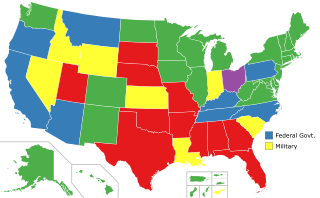
Dallas County is a county located in the central part of the U.S. state of Alabama. As of the 2020 census, its population was 38,462. The county seat is Selma. Its name is in honor of United States Secretary of the Treasury Alexander J. Dallas, who served from 1814 to 1816.

Monroe County is a county located in the southwestern part of the U.S. state of Alabama. As of the 2020 census, the population was 19,772. Its county seat is Monroeville. Its name is in honor of James Monroe, fifth President of the United States. It is a dry county, in which the sale of alcoholic beverages is restricted or prohibited, but Frisco City and Monroeville are wet cities.

In the United States, capital punishment is a legal penalty throughout the country at the federal level, in 27 states, and in American Samoa. It is also a legal penalty for some military offenses. Capital punishment has been abolished in 23 states and in the federal capital, Washington, D.C. It is usually applied for only the most serious crimes, such as aggravated murder. Although it is a legal penalty in 27 states, 20 states currently have the ability to execute death sentences, with the other seven, as well as the federal government, being subject to different types of moratoriums.
A torture murder is a murder where death was preceded by the torture of the victim. In many legal jurisdictions a murder involving "exceptional brutality or cruelty" will attract a harsher sentence if the killing is not sanctioned by authorities or carried out by state security forces themselves.

Letohatchee is an unincorporated community in Lowndes County, Alabama, United States. It has a very small population and four businesses. The community is part of the Montgomery Metropolitan Statistical Area.
The Southern Center for Human Rights is a non-profit public interest law firm dedicated to enforcing the civil and human rights of people in the criminal justice system in the South. Based in Atlanta, Georgia, it has won cases in several states in the southeastern United States, including Georgia, Alabama, and South Carolina.
Cedarbluff is an unincorporated community in Clay County, Mississippi, United States. It is located in south central Clay County along Mississippi Highway 50.

Bryan Stevenson is an American lawyer, social justice activist, law professor at New York University School of Law, and the founder and executive director of the Equal Justice Initiative. Based in Montgomery, Alabama, he has challenged bias against the poor and minorities in the criminal justice system, especially children. He has helped achieve United States Supreme Court decisions that prohibit sentencing children under 18 to death or to life imprisonment without parole. He has assisted in cases that have saved dozens of prisoners from the death penalty, advocated for the poor, and developed community-based reform litigation aimed at improving the administration of criminal justice.
Walter "Johnny D." McMillian was a pulpwood worker from Monroeville, Alabama, who was wrongfully convicted of murder and sentenced to death. His conviction was wrongfully obtained, based on police coercion and perjury. In the 1988 trial, under a controversial Alabama doctrine called "judicial override", the judge imposed the death penalty, although the jury had voted for a sentence of life imprisonment.

Anthony Ray Hinton is an American activist, writer, and author who was wrongly convicted of the 1985 murders of two fast food restaurant managers in Birmingham, Alabama. Hinton was sentenced to death and held on the state's death row for 28 years before his 2015 release.

The National Memorial for Peace and Justice, informally known as the National Lynching Memorial, is a memorial to commemorate the black victims of lynching in the United States. It is intended to focus on and acknowledge past racial terrorism and advocate for social justice in America. Founded by the non-profit Equal Justice Initiative, it opened in downtown Montgomery, Alabama on April 26, 2018.
Austin Callaway, also known as Austin Brown, was a young African-American man who was taken from jail by a group of six white men and lynched on September 8, 1940, in LaGrange, Georgia. The day before, Callaway had been arrested as a suspect in an assault of a white woman. The gang carried out extrajudicial punishment and prevented the youth from ever receiving a trial. They shot him numerous times, fatally wounding him and leaving him for dead. Found by a motorist, Callaway was taken to a hospital, where he died of his wounds.

The Legacy Museum: From Enslavement to Mass Incarceration is a museum in Montgomery, Alabama, that displays the history of slavery and racism in America. This includes the enslavement of African-Americans, racial lynchings, segregation, and racial bias.

Just Mercy is a 2019 American biographical legal drama film co-written and directed by Destin Daniel Cretton and starring Michael B. Jordan as Bryan Stevenson, Jamie Foxx as Walter McMillian, Rob Morgan, Tim Blake Nelson, Rafe Spall, and Brie Larson. It explores the work of young defense attorney Bryan Stevenson who represents poor people on death row in the South. Featured is his work with Walter McMillian, who had been wrongfully convicted of the murder of a young woman. The film is based on Stevenson's 2014 eponymous memoir, in which he explored his journey to making his life's work the defense of African American prisoners.
Madison v. Alabama, 586 U.S. ___ (2019), was a United States Supreme Court case regarding the Eighth Amendment to the United States Constitution, barring cruel and unusual punishment. The case deals with whether the Eighth Amendment prohibits executing a person for a crime they do not remember.
Elmore County is a county located in the east-central portion of the U.S. state of Alabama. Throughout its history, there have been many lynchings in the county including on July 2, 1901, when a local mob lynched Robert White. In a strange turn of events, a local farmer, George White confessed in court to the killing and named five other local men as killers. Three men were convicted in the killing and sentenced to ten years in prison. On 9 June 1902, they were pardoned by Governor Jelks.

An 18-year-old African American named William Turner was lynched on November 18, 1921, in Helena, Arkansas, for an alleged assault on a 15-year-old white girl. Two years earlier hundreds of African-Americans were killed during the Elaine Race Riot in Hoop Spur, a nearby community also in Phillips County, Arkansas.

A mob of white Vigo County, Indiana residents lynched George Ward, a black man, on February 26, 1901 in Terre Haute, Indiana, for the suspected murder of a white woman. An example of a spectacle lynching, the event was public in nature and drew a crowd of over 1,000 white participants. Ward was dragged from a jail cell in broad daylight, struck in the back of the head with a sledgehammer, hanged from a bridge, and burned. His toes and the hobnails from his boots were collected as souvenirs. A grand jury was convened but no one was ever charged with the murder of Ward. It is the only known lynching in Vigo County. The lynching was memorialized 120 years later with a historical marker and ceremony.
Jesse Thornton was a 26-year old African-American man who was lynched in the town of Luverne, Alabama, on June 22, 1940. Thornton was lynched for allegedly refusing to address a white man as "Mister". He was shot to death, and his body was thrown into the Patsaliga River. The Equal Justice Initiative documented that the white man Thornton had apparently offended by his Jim Crow infraction was a police officer.
Bud Rowland and Jim Henderson, two Black men, were lynched in Rockport, Indiana on December 16, 1900. The following day, Joe Holly was lynched in Boonville, Indiana for the same alleged crime.










